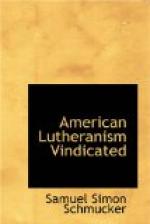Is it our duty to profess such creeds, then by arbitrary interpretations to explain away these errors, and thus endeavor to hide them from the public view? This would be injustice to the memory of their authors, and cast reproach on the principles of the Reformation, the essence of which was, that human errors must be rejected in favor of God’s Word; and that the standards or professed doctrines of the church, must in every age be conformed to her views of Scripture truth.
Is it our duty, is it the Master’s will, that we should try to believe those tenets of a creed which the Scriptures condemn? This would be treason to the Master, and be hearkening to the teachings of man rather than of God! Yet how many are there from whose lips the phrase confessional fidelity (Bekenntnisstreue,) is heard far oftener than fidelity to God’s word (Bibeltreue)!
Is it our duty to renounce the Augsburg Confession altogether? This would be the case, if its errors were fundamental. But as they are few in number, and all relate to non-fundamental points, this does not necessarily follow. As nineteen twentieths of the creed are sustained by Scripture, and embody a rich and ample exhibition of divine truth, ten times as extended as that which was invested with normative authority in the golden age, the first three centuries of the Christian church, and used as a term of Christian fellowship, we may well retain the creed, after in some way disavowing its several errors. And the historical importance of the document, as the type of a renovated Christianity, authenticated by the blessing of Heaven, renders its retention desirable, as far as it has approved itself to the conscience of the church, after the increasing philological, exegetical, and historical light of three progressive centuries.
The position of those who maintain that genuine Lutheranism demands perpetual adherence to everything contained in this Confession, yea, as some affirm, to all the former symbolical books, is utterly untenable. In the first place, these brethren forget that the symbolic system, i.e., the practice of binding ministers to the so-called symbolical books, was not adopted at the organization of the Lutheran Church, nor at any time during Luther’s life, nor until more than half a century after the rise of Lutheranism, and more than a quarter of a century after the noble Luther had gone to his heavenly rest. Symbolism is therefore no part of original Lutheranism. The efforts of Luther to reform the Romish Church began in 1517—the first regular organization of Lutheran churches was not made until some time after his excommunication by the Pope, in 1520. The first directory for Lutheran worship was published by Luther in 1523, in which, although private masses and the idea of the mass being a sacrifice had been rejected, the ceremonies of the mass, even the elevation of the host, (though not for




